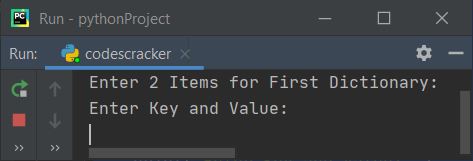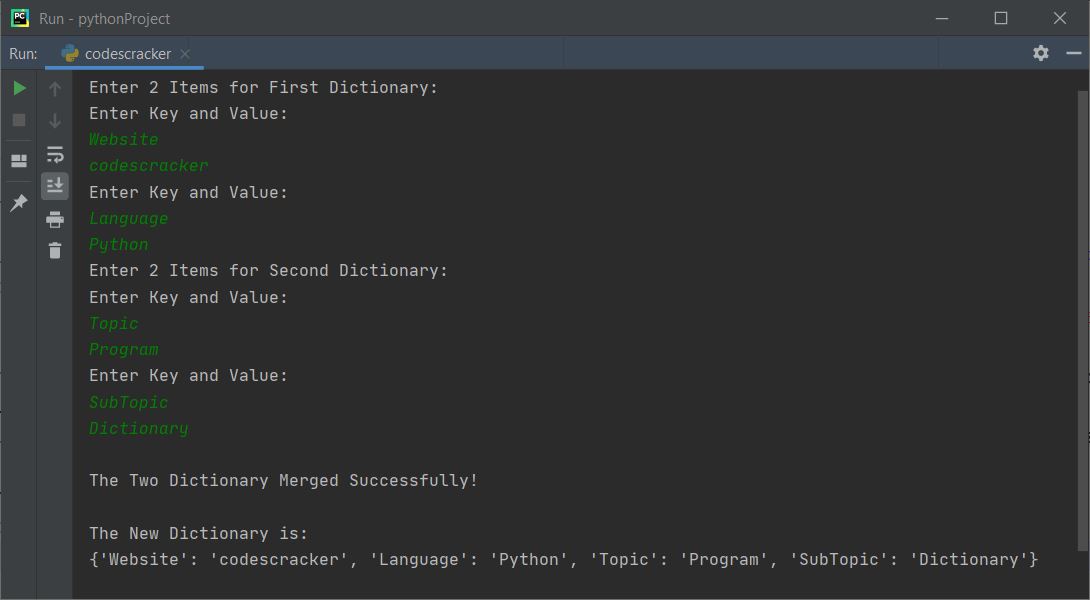- Python Basic Programs
- Python Program Examples
- Python Print Hello World
- Python Get Input from User
- Python Add Two Numbers
- Add Subtract Multiply Divide
- Python Check Even or Odd
- Python Check Prime or Not
- Python Check Alphabet or Not
- Python Check Vowel or Not
- Python Check Leap Year or Not
- Check Reverse equal Original
- Check Positive Negative Zero
- Python Check Armstrong or Not
- Python Check Palindrome or Not
- Python Check Perfect Number
- Python Find Reverse of Number
- Python Count Digits in Number
- Python Add Digits of Number
- Sum of First and Last Digits
- Python Product of Mid Digits
- Sum of Squares of Digits
- Interchange Digits of Number
- Python Sum of n Numbers
- Python Print ASCII Values
- Python Swap Two Numbers
- Python Swap Two Variables
- Python Fahrenheit to Celsius
- Python Celsius to Fahrenheit
- Python Display Calendar
- Python Days into Years, Weeks
- Find Largest of Two Number
- Find Largest of Three Number
- Python Print Fibonacci Series
- Generate Armstrong Numbers
- Python Make Simple Calculator
- Python Add Binary Numbers
- Binary Number Multiplication
- Python Mathematical Programs
- Find Sum of Natural Numbers
- Find Average of n Numbers
- Python Print Multiplication Table
- Print Table using Recursion
- Python Find Average Percentage
- Python Find Grade of Student
- Find Square Root of Number
- Python Print Prime Numbers
- Find Numbers Divisible by
- Python Find Factors of Number
- Python Find Factorial of a Number
- Python Find HCF & LCM
- Python Kilometres to Miles
- Python Find Area of Square
- Python Find Area of Rectangle
- Python Find Area of Triangle
- Python Find Area of Circle
- Python Find Perimeter of Square
- Find Perimeter of Rectangle
- Python Find Perimeter of Triangle
- Find Circumference of Circle
- Python Simple Interest
- Python Solve Quadratic Equation
- Python Different Set of Operations
- Python Display Powers of 2
- Python Find nCr & nPr
- Python Pattern Programs
- Python Print Pattern Programs
- Python Print Diamond Pattern
- Python Print Floyd's Triangle
- Python Print Pascal's Triangle
- Python List Programs
- Python Count Even/Odd in List
- Python Positive/Negative in List
- Python Even Numbers in List
- Python Odd Numbers in List
- Python Sum of Elements in List
- Sum of Odd/Even Numbers
- Python Element at Even Position
- Python Element at Odd Position
- Python Search Element in List
- Python Largest Number in List
- Python Smallest Number in List
- Python Second Largest in List
- Python Second Smallest in List
- Python Insert Element in List
- Python Delete Element from List
- Python Multiply Numbers in List
- Swap Two Elements in List
- Python 1D Array Program
- Python Linear Search
- Python Binary Search
- Python Insertion Sort
- Python Bubble Sort
- Python Selection Sort
- Remove Duplicates from List
- Python Reverse a List
- Python Merge Two List
- Python Copy a List
- Python Conversion Programs
- Python Decimal to Binary
- Python Decimal to Octal
- Python Decimal to Hexadecimal
- Python Binary to Decimal
- Python Binary to Octal
- Python Binary to Hexadecimal
- Python Octal to Decimal
- Python Octal to Binary
- Python Octal to Hexadecimal
- Python Hexadecimal to Decimal
- Python Hexadecimal to Binary
- Python Hexadecimal to Octal
- Python Matrix Programs
- Python Add Two Matrices
- Python Subtract Two Matrices
- Python Transpose Matrix
- Python Multiply Matrices
- Python String Programs
- Python Print String
- Python Find Length of String
- Python Compare Two Strings
- Python Copy String
- Python Concatenate String
- Python Reverse a String
- Python Swap Two Strings
- Python Uppercase to Lowercase
- Python Lowercase to Uppercase
- Python Check Substring in String
- Python Count Character in String
- Count Repeated Characters
- Python Count Word in Sentence
- Python Count Each Vowels
- Python Capitalize Character
- Python Capitalize Word in String
- Python Smallest/Largest Word
- Remove Spaces from String
- Remove Duplicate Character
- Remove Vowels from String
- Remove Punctuation from String
- Python Remove Word in String
- Python Remove Duplicate Words
- WhiteSpace to Hyphens
- Replace Vowels with Character
- Replace Character in String
- Python Sort String in Alphabetical
- Sort Word in Alphabetical Order
- Extract Number from String
- Python Check Anagram Strings
- Python File Programs
- Python Read a File
- Python Write to File
- Python Append Text to File
- Python Copy Files
- Python Merge Two Files
- Python Counts Characters in File
- Python Count Words in File
- Python File Content in Reverse
- Python Lines Contains String
- Python Delete Line from File
- Python Capitalize Word in File
- Python Replace Text in File
- Replace Specific Line in File
- Python Find Size of File
- Python List Files in Directory
- Python Delete Files
- Python Misc Programs
- Python Reverse a Tuple
- Python Merge Two Dictionary
- Python bytes to String
- Python bytearray to String
- Generate Random Numbers
- Python Print Address of Variable
- Python Print Date and Time
- Python Get IP Address
- Python Shutdown/Restart PC
- Python Tutorial
- Python Tutorial
Python Program to Merge Two Dictionaries
This article deals with some Python programs that merges two dictionaries. Here are the list of programs available in this article:
- Merge two dictionaries using copy() and update() Methods
- Merge two dictionaries without using third dictionary
- Merge two dictionaries entered by user
- Allow user to define the size and items of both dictionaries, and then perform merging operation
Merge Two Dictionaries using copy() and update()
The question is, write a Python program to merge two dictionaries using copy() and update(), predefined methods of Python. The program given below is answer to this question. This program uses the help of third dictionary to do the task. This program also does not interact with users at run-time.
DictionaryOne = {"key1": "Value1", "Key2": "Value2"}
DictionaryTwo = {"key3": "Value3", "Key4": "Value4"}
DictionaryThree = DictionaryOne.copy()
DictionaryThree.update(DictionaryTwo)
print("\nThe Two Dictionary Merged Successfully!")
print("\nThe New Dictionary is:")
print(DictionaryThree)
Here is its sample output:

Merge Two Dictionaries without third Dictionary
Now this is the program that does takes any help of third dictionary. This program also does not interact with users. That is, this program does not allows user to enter any input values for any of the dictionary.
DictionaryOne = {"key1": "Value1", "Key2": "Value2"}
DictionaryTwo = {"key3": "Value3", "Key4": "Value4"}
DictionaryOne.update(DictionaryTwo)
print("\nThe Two Dictionary Merged Successfully!")
print("\nThe New Dictionary is:")
print(DictionaryOne)
This program produces the same output as of previous program.
Merge Two Dictionaries with User Input
The question is, write a program in Python that asks from user to enter values for the two dictionaries and then merges both dictionaries. Here is its answer. This program only receives two-two items from user for both dictionaries.
DictionaryOne = {}
DictionaryTwo = {}
print("Enter 2 Items for First Dictionary: ")
for i in range(2):
print("Enter Key and Value: ")
dictKey = input()
dictVal = input()
DictionaryOne.update({dictKey: dictVal})
print("Enter 2 Items for Second Dictionary: ")
for i in range(2):
print("Enter Key and Value: ")
dictKey = input()
dictVal = input()
DictionaryTwo.update({dictKey: dictVal})
DictionaryOne.update(DictionaryTwo)
print("\nThe Two Dictionary Merged Successfully!")
print("\nThe New Dictionary is:")
print(DictionaryOne)
The snapshot given below shows the initial output produced by this Python program:

Now supply inputs say Website as key of first item for first dictionary, codescracker as value of first item for first dictionary. Similarly Language and Python as key and value of second item for first dictionary. Again enter Topic and Program as key and value of first item for second dictionary. And finally SubTopic and Dictionary as key and value of second item for second dictionary, to merge and print the newly merged dictionary as shown below:

Merge Two Dictionaries of Given Size and Items
This is the actual and modified version of all the previous programs. This program allows user to define the size and items for both the dictionaries. After receiving the inputs for dictionaries, the program merges both the dictionaries.
dOne = {}
dTwo = {}
print(end="Enter the Size of First Dictionary: ")
dOneSize = int(input())
print(end="Enter " +str(dOneSize)+ " Items:-\n")
for i in range(dOneSize):
print(end="Enter Key and Value of Item No." +str(i+1)+ ": ")
dKey = input()
dVal = input()
dOne.update({dKey: dVal})
print(end="\nEnter the Size of Second Dictionary: ")
dTwoSize = int(input())
print(end="Enter " +str(dTwoSize)+ " Items:-\n")
for i in range(dTwoSize):
print(end="Enter Key and Value of Item No." +str(i+1)+ ": ")
dKey = input()
dVal = input()
dTwo.update({dKey: dVal})
dOne.update(dTwo)
print("\nThe Two Dictionary Merged Successfully!")
print("\nThe New Dictionary is:")
dLen = len(dOne)
for m, n in dOne.items():
print(str(m)+ ": " +str(n))
Here is its sample run with following user input:
- 2 as size of first dictionary
- Time and 10.59 AM and key and value of first item
- Day and Wednesday as key and value of second item
- 3 as size of second dictionary
- Month and January as key and value of first item
- Year and 2021 as key and value of second item
- Website and codescracker.com as key and value of third item
Let's have a look at the sample run with exactly these inputs:

« Previous Program Next Program »